Tsunami Survival: The Isolated Tribes of Andaman and Nicobar Islands
Air Date: Week of January 7, 2005
Host Steve Curwood talks with Sophie Grig of Survival International, a worldwide organization supporting tribal peoples. She's been tracking information on the effect of the tsunami on the isolated tribes of the Andaman and Nicobar Islands. Some of these tribes are hunter-gatherers who came to the islands from Africa 60,000 years ago. It's believed that many tribal members of the Andamans survived the tsunami, while the Nicobar Island tribes may not have fared as well.
Transcript
CURWOOD: From the Jennifer and Ted Stanley Studios in Somerville, Massachusetts, this is Living on Earth. I’m Steve Curwood.
As aid and recovery teams labor in the wake of the Indian Ocean earthquake and tsunami, thousands of people are still listed as missing. At first there were concerns that some tribes that go back more than 60,000 years had been swept away. But now it appears that some - though certainly not all - of these tribes on islands that include the Andaman and Nicobar in the Bay of Bengal may have fared reasonably well, considering.
These tribes include the Sentinelese, the Onge, the Jawara and the Great Andamanese. Many have fiercely protected their hunter-gatherer lifestyles despite attempts at colonization.
Sophie Grig is a campaigner for Survival International, an organization supporting tribal peoples. Sophie, is it possible that the cultural practices of these tribes who survived helped protect them from the tsunami?
GRIG: It’s difficult to know because actually incredibly little is known about the tribes on the Andaman Islands. Some of the tribes we know absolutely nothing about. The Sentinelese, nobody can speak a word or their language. We don’t even know what they call themselves – it certainly isn’t Sentinelese. They will have a very close relationship with the nature, they live by hunting and gathering, they fish in the sea with bows and arrows.
 An inlet of India's Little Andaman Island, located in the eastern Indian Ocean, shows damage caused by the December 26, 2004, tsunami in this satellite image. (Image courtesy NASA.)
An inlet of India's Little Andaman Island, located in the eastern Indian Ocean, shows damage caused by the December 26, 2004, tsunami in this satellite image. (Image courtesy NASA.)
They’ve been there for 60,000 years. We understand that probably about every 10,000 years there’s been an earthquake or a tsunami or something that’s affected the area by looking at the geography of it. And so, we understand that probably they’ve had a lot of experience with this in their people’s history, and so probably they do have mechanisms and an understanding, much more than the more recent settlers who wouldn’t have known what to do.
CURWOOD: How did the topography of these islands protect some of these tribes from the worst effects of the tsunami?
GRIG: Well, the areas where the tribal people tend to be are the areas where, actually, there’s been the least ecological damage. And I understand that coral reefs and mangrove swamps are actually very good at dissipating the power of a tsunami. And where the tribal people are is the area where the forests haven’t been damaged, and where the mangrove swamps haven’t been damaged, and where the coral reefs are most intact. So it’s quite possible that by defending their land from the aggression of the outsiders, and from the cultivation and destruction that much of the islands have suffered from, the tribal peoples themselves, actually, that also added to help them in the wake of the tsunami.
CURWOOD: Now, help me in another area. This is not your expertise, but we’ve seen a number of news wire stories that have suggested that many animals survived the tsunami because they had some sort of a sixth sense that an earthquake was coming, and maybe they knew intuitively to head to higher ground. What of those stories do you link to what happened with these aboriginal people?
GRIG: Well, I think it’s quite likely. I mean, the tribal people who live in the forest, they live from hunting the animals. They have an extremely intimate relationship with the animals and an extremely good understanding of what the animals are doing and what they’re thinking, and that’s how they can successfully hunt and live in the forest. And so they may well have watched the animals and seen what the animals were doing and followed their lead. Or maybe they also just have a very, such a close relationship with the land, that they understand what’s happening, too.
 |
 |
|
|
|
GRIG: Well I know that people heard tremors. I’ve spoken to scientists who were in the Andaman Islands who felt the tremors and, you know, their instant thought was “Get out of the house, get out into open ground,” and then thought, “Oh no, we’re on an island, if you hear a tremor there’ll be a tidal wave that will follow it.” And so them it was a knowledge that they’d gathered from science; it’s quite likely that the tribal people who’ve been there for so many years, maybe in their folklore and their stories they know that if you feel a tremor that means that a wave will follow. No one knows their language well enough, really, to be able to ask them and to discuss issues like their legends and their stories. But it’s quite possible that that’s where they passed on this wisdom and this understanding about getting to higher ground. CURWOOD: Now, as I understand it the Nicobarese of Car Nicobar Island, who are not hunter gatherers but folks who grow some of their crops on plantations, I understand that they are believed to have had a substantial loss of human life. Do we know how many lives we’re talking about here? And why do think this tribe was hardest hit by the tsunami? GRIG: Well, mostly it’s geography, I think. Car Nicobar did get the worst of the wave. It’s the closest to the epicenter of the earthquake. And so, really, I think they had no chance. I mean, most of the people didn’t have time to flee even if they had been able to sense something. A lot of it is just to do with where they were, and they were just extremely unlucky to be there. They have been assimilated. They have much more contact with outsiders. For many years they’ve been trading with spice traders and people for hundreds of years, and they have recently taken to plantations and farming. And so they probably don’t have such a close relationship with the land as the hunter-gatherering people, and so maybe they don’t have such a close intuition. But I think, largely, it’s geography that was their downfall. CURWOOD: What steps are outside organizations such as yours, Survival International, taking to help these people? GRIG: Well it’s incredibly difficult. The Indian authorities don’t allow any foreigners to go to the Nicobar Islands anyway. I mean, they’re completely closed to outsiders because of the big naval bases that they have there. I know that a lot of the agencies are very frustrated because they want to be getting in, they want to be taking in aid, and they want to be able to help. There was a big evacuation program to get people out and there are aid agencies in Port Blair, which is the capital of the Andaman Islands, where some people have been evacuated to. But actually it’s been very frustrating because no one really has been able to help very much in the Nicobar Islands. CURWOOD: Now what about aid for the other tribes? Might the more isolated tribes such as the Jawara and the Sentinelese accept aid from relief organizations or the Indian government? GRIG: Probably not. I mean the Sentinelese, when the helicopter flew over and did drop some supplies, fired arrows at it, which suggests they weren’t very keen on anything from outsiders. And they generally repel any gifts that they’re given. Because these tribes are not used to anything from outside. They don’t rely on anything. They’re not dependent on anything. As long as their fresh water sources have remained intact they should be absolutely fine. There’s no reason why they shouldn’t be able to just carry along as they were doing before. It’s the tribes like the Onge and the Great Andamanese and the Nicobarese who are either reliant on the administration for their food, like the Onge and the Great Andamanese, or the Nicobarese, who had an infrastructure and relied on that for their existence. Those are the tribes that are going to need help. CURWOOD: Sofie Grig is Survival International’s Andaman’s campaigner. Thanks for taking this time with me today. GRIG: Thank you very much. Links
|





